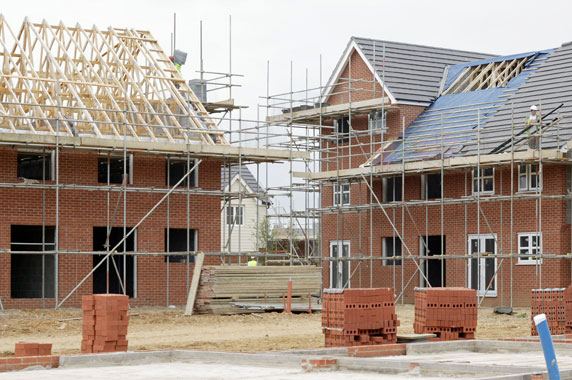Homebuilders are facing a raft of new taxes from various government departments that are posing a serious threat to businesses, housing supply and the additional social and economic benefits provided by one of the UK’s biggest drivers of growth.
A new report by the Home Builders Federation, ‘Building Homes in a Changing Business Environment’, identifies 12 new taxes, levies and regulations, that, whilst mostly meritorious, cumulatively pose a serious challenge to the industry’s ability to function and deliver new homes.
The bill, which totals an estimated £4.5 billion a year and adds £20,000 on to the cost of building each new home, includes two new industry specific taxes to fund remediation of buildings over 11m built by foreign developers, public bodies or untraceable companies; new regulations that will necessitate changes to heating systems in new homes; electric vehicle charging points for all new homes and a slew of effective taxes imposed unofficially by quango Natural England.

The past nine years have seen housing supply in England double as home builders responded to positive policy changes aimed at reversing several decades of undersupply with efforts made by policymakers to address the housing affordability crisis. Despite a broadly positive business environment over this period, many smaller builders have struggled and there is a general recognition that the planning process is failing to deliver swiftly and with a reasonable degree of certainty. These problems are increasingly exacerbated by intervention from Government agencies.
The creeping cumulative burden of new financial regulations and policies, all due to take effect between summer 2022 and spring 2025, will have a critical impact on the industry and its ability to deliver on Government housing delivery aspirations.
At present there is little understanding of the interplay between the various items, the cumulative burden that they represent or the impacts on housing supply or in the delivery of infrastructure and affordable housing. The report highlights how the first consequence of this burden will likely be on the Section 106 and Community Infrastructure Levy contributions that local authorities receive for affordable housing and other important community services, such as education provision. With the supply of new Affordable Homes predominantly now reliant on private sector cross-subsidy, there will inevitably be an impact on the provision of new Social Rented homes and other Affordable tenures. Research published earlier this year suggested that the introduction of just one of these measures, the Building Safety Levy, would result in up to 70,000 fewer Affordable Homes built over the next decade.
The regions most likely to be affected by this are in Northern England and the Midlands, which threaten to undermine the housing component of the Government’s Levelling Up agenda. While many of the measures fall equally on all regions and types of development, the Biodiversity Net Gain (BNG) requirements which have been broadly supported by the sector will impose costs on development in Yorkshire which are expected to be three times the impact in London.
The industry opposes in concept very few of these measures, but HBF is urging the new Government and ministerial team to take stock of the vast number of additional cost burdens imposed on housing delivery that come from right across Whitehall and take a sensible approach to the introduction of these. While asking for a more considered approach to the implementation of many of these measures, the sector continues to call on the Government to urgently address:
- The free reign afforded to Natural England to ransom housing developments across a third of England because of nutrient pollution caused principally by agricultural practices and the lack of investment by water companies in the networks they operate
- The unfairness of hitting the sector with a second industry-specific tax in a matter of months, both of which are intended to pay for the same remediation of medium- and high-rise buildings built by other actors. The £3bn Building Safety Levy comes in addition to the Building Safety Pledge signed by almost 50 UK developers and which is estimated to be worth more than £2bn and the 4% Corporation Tax surcharge on UK home builders which took effect in April 2022, but which is not paid by foreign developers operating in this country which is also expected to extract up to £3bn from firms
Stewart Baseley, Executive Chairman of HBF, said: “The cumulative bill facing homebuilders over the next few years is extremely concerning. While the industry is supportive of the need to adapt to new social, economic and environmental circumstances, builders have been left to shoulder the financial burden with little serious thought about the real implications for housing delivery and services.
"The additional costs carried by developers will make the planning, delivery and sale of new homes more marginal and, in some cases, unviable, threatening jobs, affordable housing and investment in facilities that local communities desperately need.
"It is crucial that the new Government re-evaluates the impacts of these costs and ensures that the industry is sufficiently supported in their introduction.”
The identified annual costs are as follows:
- Energy conservation: Part L - £750 million
- Accessibility: Part M - £310 million
- Future Homes Standard – £1.9 billion
- Future Buildings Standard - £100 million
- Building Safety Levy - £300 million
- Residential Property Developer Tax - £250 million
- Red diesel rebate removal - £42 million
- Biodiversity Net Gain - £256 million
- Nutrient neutrality - £337.5 million
- Water neutrality - £5 million
- Recreation mitigation - £42 million
- Electric vehicle charging: Part S - £206.2 million




















